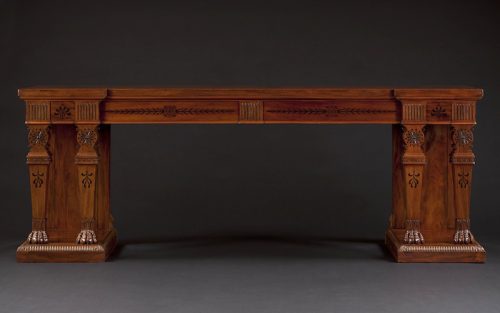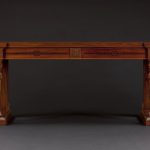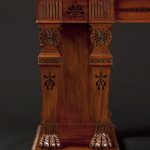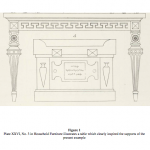9828 AN IMPOSING MAHOGANY AND EBONY INLAID SIDE TABLE IN THE MANNER OF THOMAS HOPE English. First Quarter Of The 19th Century. Measurements: H: 35 1/2″ (90 cm) L: 96″ (244 cm) D: 25″ (64) cm

Research
Of mahogany with ebony inlay and applied motifs. The rectangular top above an ebony inlaid frieze concealing two drawers. The four classically conceived front legs are inlaid with anthemions and set with raised ebony sections. The rear supported by two paneled uprights, the whole raised on a plain plinth with knulled edge. Formerly with a brass gallery.
Provenance:
Private collection Buenos Aires
This side table was created in the manner of the Anglo-Dutch banker, collector, and theorist, Thomas Hope (1769-1831). In 1787, Hope embarked on his Grand Tour, which took a decade to complete and brought him to Greece, Italy, France, Spain, Germany, the Ottoman Empire and North Africa. The ancient Egyptian, Greek and Roman architecture and artifacts he studied during this time had a profound influence on his furniture designs, which were published in his 1807 book entitled Household Furniture and Interior Decoration.
The purpose of the publication, which provided a detailed and faithful inventory of his London house in Duchess Street, was to accurately record his original designs and thereby prevent any more “extravagant caricatures”1 of his style, which had “begun to start up in every corner of this capital.”2 The book had an enormous impact on contemporary fashion and certainly fulfilled its intended purpose, for in 1827 John Britton could write that it had “not only improved the taste of cabinetmakers and upholsterers, but also that of their employers.”3
Plate XXVI, No. 3 in Household Furniture illustrates a table which clearly inspired the supports of the present example (figure 1). On each, the tapering legs are headed by circular medallions centered by rosettes, and surrounded by four smaller carved circles, creating corners, above a repeating “bolt head” motif, a component of ancient Greek furniture found, for example, at the tops of marble table legs. On the present table these designs, along with inlaid anthemion and foliate decoration, are realized in ebony, a material often used by Hope and prized by the ancients; it’s genus name, Diospyros, meaning “the fruit of the gods” in ancient Greek.
Footnotes:
1. Watkin, David; Thomas Hope and the Neo-Classical Idea; London, 1968, p. 223.
2. Ibid. 224
3. Ibid.



Comments are closed.